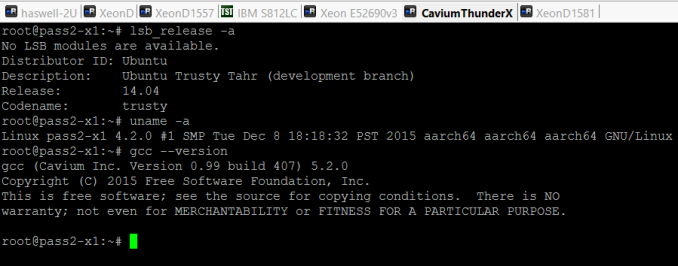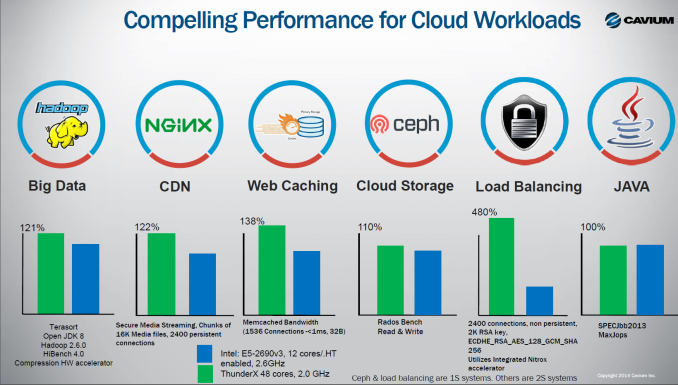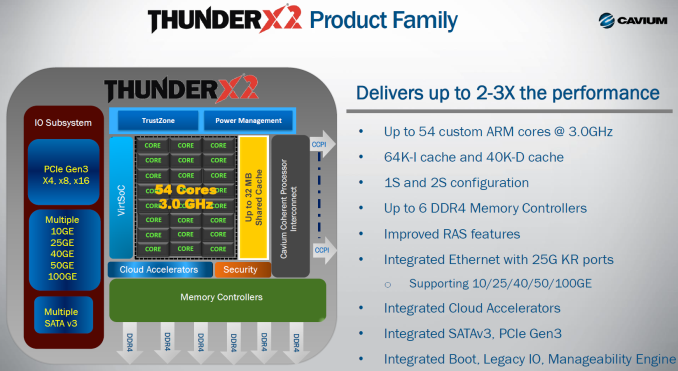Investigating Cavium's ThunderX: The First ARM Server SoC With Ambition
by Johan De Gelas on June 15, 2016 8:00 AM EST- Posted in
- SoCs
- IT Computing
- Enterprise
- Enterprise CPUs
- Microserver
- Cavium
Limitations of This Review
Before we get to our closing thoughts, I want to talk a bit about what we were and weren't able to do in our testing, and in what ways this limits our review. The still somewhat "rough on the edges" software ecosystem gave us a lot of headaches. Our setup was a Ubuntu 14.04 with lots of customized (Cavium's beta gcc compiler, MySQL version ThunderX 5.6) and newer software (the Linux kernel 4.2). The result was that we were slowed down by a large number of solvable (but time consuming) software and configuration problems.
Don't get me wrong: Linux on ARM has come a long way. Most software works, the exception was Spark 1.5 (Java based) which crashed with a very low level message. Still, it took quite a bit of time to get software configured correctly, while on x86 it is simply a matter of using "apt-get install".
Cavium told us that they expect that these problems will be solved in Ubuntu 16.04, and a firmware upgrade to support the new Ubuntu is on its way. That is also why we were not able to test our most real world and relevant benchmarks, such as our webserver tests. Webcaching, light webserving and Contend Delivery Networking might fit the ThunderX well as it has access to more memory and networking bandwidth than the Xeon D.
But webservers require a lot of software components (caching layer, webserver, interpreter etc.) that have to work together well. So we wait for 16.04 and the new firmware to arrive to build these complex tests.
Closing Thoughts
Exploring a new ambitious server SoC is always an interesting journey, but also a very time intensive one. We had to find out what the real performance profile of the ThunderX, not the perceived or advertised one. There have been both good and bad surprises in our journey.
Let's start with the bad: the blocking L1 cache, high latency L2-cache and high latency DRAM access are lowering the scalability of the 48 cores in a whole range of software. The ThunderX could still be a good candidate as front-end webserver, but Cavium has to solve the high power usage at low loads. Power management seems to be more problematic than single-threaded performance. Cavium promises that ThunderX2 will vastly improve power management by letting hardware handle much more of the management duties. But the current ThunderX power management capabilities seem to be rather basic. Cavium's information is sketchy at best.
The Xeon D, by comparison, offers superior performance per watt: twice as good as the ThunderX. It is clear that the ThunderX is not a good match for heavy database servers, nor for enterprise workloads where energy consumption at low load is a high priority.
The good. The 12 and 16-core Xeon Ds ($1300-$1800) and midrange E5s ($900-$2000, not including 10 GBe NICs) cost quite a bit more than the ThunderX ($800). Gigabyte could not tell us how much the R120-T30 would cost, only that the pricing would be "competitive with similar midrange Xeon E5 servers".
Although single-threaded performance is low, it is definitely not as terrible as commonly assumed. We found out that the raw integer computing power of the Thunder-X is about one-third that of the best Xeon Ds, not one-fifth as claimed in advertising materials (a difference of 65%). The ThunderX core is almost as good as the A57, while it consumes quite a bit less power and thus offers a better performance-per-watt than the latter. On the condition that you give it enough DRAM, the 48 cores are able to offer the Java performance of a midrange Xeon E5, even when we expect the system to remain under a certain response time.
Those facts – better than expected single threaded performance and midrange Xeon E5 throughput – make a world of difference. And we have yet to test the ThunderX in situations that is was really built for: network-intensive ones. The XML processing and h264 substests (SPEC CPU) indicate that there is definitely some truth in Cavium's claims that the ThunderX shines as a compute engine of a load balancer, web cache or CDN server.
As single threaded performance (SPEC CPU) is not as dramatic as commonly assumed and Java performance is already very close to what was promised, this puts the forthcoming ThunderX2 in a different light.
Using the new 14 nm FinFET technology of GlobalFoundries, Cavium claims it will reach 2.6-3.0 GHz and get a lot of microarchitectural improvements. This should result in twice as much performance per core. If indeed the ThunderX2 can offer single threaded performance at the level of the low end Xeon D (1.3-1.5 GHz), that might place it in the "SoCs with acceptable single threaded performance" and opens up new markets. Time will tell, but Cavium has proven it can deliver SoCs in a timely manner. And the fact that Cavium allows independent testing instead of just showing numbers on PowerPoint presentations tell us that they have confidence in the future of their ARMv8 endeavors.













82 Comments
View All Comments
willis936 - Thursday, June 16, 2016 - link
Are you sure that the there are more cores at lower clocks to keep voltage lower? Power consumption is proportional to v^2*f.ddriver - Friday, June 17, 2016 - link
Say what? Go back, read my previous post again, and if you are going to respond, make sure it is legible.willis936 - Friday, June 17, 2016 - link
Alright well if you don't understand why many slower cores are more power efficient even if there was a 0 cycle penalty on context switching then you aren't worth having this discussion with.blaktron - Wednesday, June 15, 2016 - link
48 cores of server processing on 16mb of l2 and 4 channels of RAM? What is this thing designed for. Will be like running single channel celerons as server processors, so decent hypervisor hosts are out, and so is any database work more complex than dynamic web pages.Haravikk - Wednesday, June 15, 2016 - link
Facebook is specifically mentioned as being interested in this, so dynamic web-pages is definitely a valid use-case here. HHVM for example is pretty light on memory usage (so is PHP7 now), especially in high demand cases where you're really only running a single set of scripts, probably cached in a compiled form, plus both scale really well across as many cores as you can throw at them.Things like nginx and MariaDB will be the same, so they're absolutely intended use-cases for this kind of chip, and I think it should be very good at it.
blaktron - Wednesday, June 15, 2016 - link
With no L3 and slow RAM access I'm not sure where you think the scrips will cache. Assuming you ran them on bare metal (horrifying waste of compute) there would be enough, but if you had docker instances or quick spin vms doing your work (as 99% of web servers are) then each instance will only get the tiniest slice of cache to work with. It would be like running your servers, as I said, on a bank of celerons. Except celerons have L3 and don't carry 12 cores per memory channel.spaceship9876 - Wednesday, June 15, 2016 - link
Hopefully someone will release a server chip using 64 cortex A73 cpu cores, i'm pretty sure the cortex a73 will be more power efficient than xeon d. Xeon d beats cortex a57 in power efficiency but i'm pretty sure than cortex a72 will be similar and cortex a73 will beat it.Flunk - Wednesday, June 15, 2016 - link
ARM with ambition?I've heard that before, nothing came of it.
CajunArson - Wednesday, June 15, 2016 - link
Interesting article. This does appear to be the first semi-credible part from an ARM server vendor.Having said that, the energy efficiency table at the end should put to rest any misconceived notions that ARM is somehow magically energy efficient while X86 isn't.
Considering that Xeon E5-2690 v3 is a 4.5 year old Sandy Bridge part made on a 32 nm process and it still has better performance-per-watt than the best ARM server parts available in 2016, it's pretty obvious that Intel has done an excellent job with power efficiency.
kgardas - Wednesday, June 15, 2016 - link
2 CajunArson: (1) you can't compare energy efficiency of CPUs made on different nodes. 28nm versus 14nm? This is apple to oranges. (2) Xeon E5-2690 *v3* is Haswell and not Sandy Bridge and it's not 4.5 years definitely.